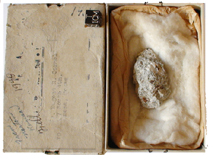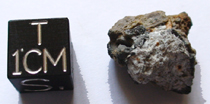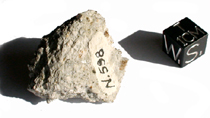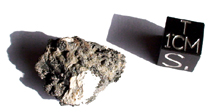Aubrites
The aubrites are named for Aubres, a small meteorite that fell near
Nyons, France, in 1836. Consisting primarily of the orthopyroxene
enstatite, they are also called enstatite achondrites. Aubrites represent
evolved rocks of igneous origin and are not to be confused with primitive
enstatite-rich achondrites such as Zaklodzie or Itqiy. Due to their
typical light-colored fusion crusts, their white interiors, and their
fragile compositions, most aubrites in our collections are witnessed falls
or finds from the blue-ice fields of Antarctica. Excluding all probable
pairings, only 16 distinct members are known. Strangely, very few aubrites
has been recovered from the hot deserts. Aubrites are very rare
achondrites.
|
Norton County
Aubrite
fell on February 18, 1948 at 4 PM
in Kansas, USA
TKW 1000 Kg
|
 
|
|
|
|
Norton
County -00
Large fragment from the Eugene Cornelius collection. Was found
and traded by H.O. Stockwell. Comes with the original US post box
sended by Stockwell in the early 50's.....
28.74gr
price on
request |
|
|
|
|
|
|
|
Norton County -01
the best ever seen fragment with regmaglypted black
& White crust, has a giant enstatite crystal..
43.60gr !!!
Price on request
|
|
|
|
  |
|
|
|
|
|
|
 
|
|
|
|
Norton
County -02
half individual with creamy crust + heavy bubbling !!!!
2.43gr
Sold |
|
|
|
|
|
|
|
Norton
County -03
Very attractive piece of Aubrite with a number of
New Mexico Museum !
SOLD
Price on
request
|
|
|
|
 
|
|
|
|
|
|
|
 
|
|
|
|
Norton
County -04
impact melt fragment with fusion crust
4.05gr
SOLD
|
|
|
|
|
|
|
|